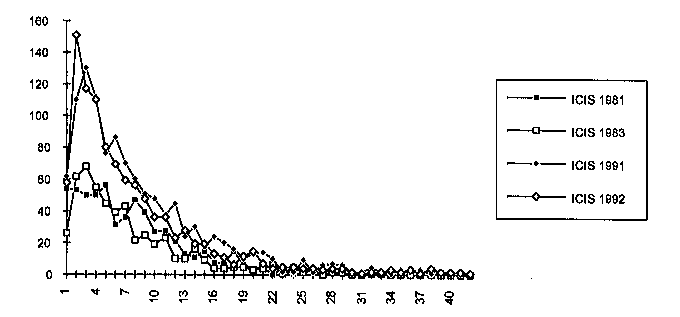
Age at time of citation
Figure 1. Distribution of ages of references found in ICIS proceedings
Sally Jo Cunningham
Dept. of Computer Science
University of Waikato
Private Bag 3105
Hamilton
New Zealand
sallyjo@waikato.ac.nz
Abstract: A synchronous study on four years' proceedings of the International Conference on Information Systems (ICIS) is conducted in order to determine the obsolescence rate for Information Systems (IS) literature. This study finds that IS literature has a relatively high obsolescence rate, similar to that of literature in the fields of engineering and technology-dependent "hard" sciences. In addition, this study provides a categorization of the types of documents referenced by IS research, and presents an analysis of the obsolescence rate for these types. This type of categorization permits a finer-grained examination of patterns of information dissemination and use.
1. Introduction
Scholarly documents may be thought of as possessing a life-cycle: a document is "born" at publication, lives a productive life during the time span in which subsequently published articles reference it, and finally "dies" when it is no longer cited. Many documents, of course, are "still-born". Studies indicate that between one-quarter (Koshy, 1976) and one-third of all scientific articles are never cited (Computer Horizons, 1976). Many others live only briefly: the average annual citation count for scientific documents that do manage to be cited is only 1.7 (Garfield, 1977), and most scientific papers die within 10 years of publication (Price, 1965, as referenced in Diodato, 1993).
During this life-cycle, the usage that a document enjoys is not steady. Bibliometric studies have validated the common sense assumption that references to an individual document in a subject literature tend to decrease with the age of the document [see, for example, Diodato, 1993; Stinson, 1987]. Typically, documents receive their greatest number and frequency of citations immediately after publication, and the frequency of citation falls rapidly as time passes. Therefore, the document is said to be aging, and when it ceases to be cited it is obsolete.
However, "obsolescence" is a slightly misleading term, as it implies that the information in a document has been discovered to be incorrect or no longer applicable. There are several other reasons why a document may cease to be cited. As a research finding becomes better known, it will appear in review articles that may get cited in place of the original publication. Eventually the contents of a document may become so thoroughly incorporated into a field that its findings are held to be common knowledge and the original document itself is no longer cited: "obliteration by incorporation" (Garfield, 1977). Moreover, a researcher may not select the "best" work for citation, but instead often chooses documents on a basis of accessibility (including factors such as the physical availability of a format, the language of publication, and the inclusion in indexing services.) (Smith, 1981). Finally, the characteristics of the users may be as important as the characteristics of a document in determining a document's rate of aging (Griffith, 1979). For example, an active researcher will likely require up-to-the-minute information in a given field; a textbook author will range back through earlier work to present more fundamental and generally accepted results to students; and a historian of science may reference texts that are centuries old and whose scientific findings have long been discredited.
The obsolescence rate of a body of literature, rather than that of a single document, is an estimate of the rate of aging for documents in that field. Different disciplines have different obsolescence rates, with the humanities and social sciences generally making longer active use of scholarly documents than the sciences. Obsolescence studies are one tool for examining the patterns of information generation, dissemination, and use in a research community.
Examination of past obsolescence rates allows us to chart general changes in the modes of scholarship over the years; evaluation of obsolescence studies rates for distinctive geographic regions and sub-topics will allow us to draw contrasts between research methods found in different countries and within different research cliques. A deeper understanding of the subject methods and how they change can only be beneficial in producing quality work in the future.
Studies on obsolescence have concentrated primarily on the physical and natural sciences, and to a lesser extent on the social sciences and humanities. Literatures in the fields of management, information systems, and information technology have scarcely been examined by bibliometricians and scientometricians [representative studies include Evaristo, 1993; Prechelt, 1994; and Hall, 1985]. Few obsolescence studies have been conducted in these subjects [for example, see Cunningham and Bocock, 1995]. This study examines one type of the IS literature - the International Conference on Information Systems (ICIS) conference proceedings - as a preliminary attempt to quantify the obsolescence rate of the IS literature. This study also categorizes the types of documents referenced by ICIS papers, and examines their respective obsolescence rate.
2. Research Methodology
Two types of measures are in common use: synchronous obsolescence and diachronous obsolescence. For the latter metric, a sample of documents is selected from a point in the past, and the rate of citations to these documents are calculated on a year-by-year basis (generally through use of a citation index). Typically a "half life" is calculated as the time period in which half of all observed citations are received by the document set.
In contrast, a synchronous obsolescence rate is determined by proceeding from the present to the past: the publication dates of documents referenced by a sample set of documents are examined to determine how far back in time the more recent half of those references were published. This measure is called the median citation age.
The synchronous obsolescence rate is easier to calculate, since it requires access to the sample documents alone, without recourse to a citation index. Whether synchronous and diachronous obsolescence are statistically equivalent is debatable (Stinson, 1987; Gupta, 1990); they are largely complementary, since secondary calculations for the two measures give different insights into the same subject literature.
The information systems/information technology literature has a wide "spread" across diverse subject fields such as computing, mathematics, management, science, and social sciences, making it particularly difficult to trace citations through relevant indices. For that reason, a synchronous methodology was chosen. In turn, the proceedings of the ICIS conference was chosen for analysis because ICIS is a general IS conference that publishes a wide sampling of topics from the information systems field.
Technique for calculating median citation age
This study applies the discrete analysis method to calculate the median citation age for an article: publication years are treated as discrete units, rather than as a continuum of quarters, months, and weeks. To determine the median citation age for a single article, the publication dates of its references are first listed in reverse chronological order. For example, the reference dates for this paper are:
1995, 1994, 1993, 1993, 1990, 1989, 1988, 1988, 1987, 1986, 1985, 1982, 1981, 1979, 1979, 1977, 1977, 1976, 1976, 1970
The median year is 1985.5 (the average of the 10th and 11th of the 20 values). Subtracting 1985.5 from the year of publication yields a median citation age of 9.5 years (1995-1985.5).
This same procedure is applied to a sampling of articles from the field in determining the median citation age for a given subject. When the median citation age is calculated for more than one year of publication, the study is called multisynchronous.
Data collection
The selection of a body of literature and range of years as a focus for a bibliographic study is often dependent on pragmatic as well as theoretical factors: availability of documents, ease of access, etc. While these factors played a part in the choice of subject for this study, the proceedings are selected for analysis also because of the prominence of the ICIS conference in the IS field and its wide coverage of IS topics.
This study analyzed a total of 3308 references from 102 articles, and calculated the median citation ages for the 1981, 1983, 1991, and 1993 ICIS proceedings (Table 1). Only full research articles were included in the study. Short papers and panel discussions were excluded due to their different referencing conventions. The multisynchronous methodology (spreading over a decade) provides a more statistically viable basis for evaluation, as well as pointing up changes in the referencing conventions over the period studied.
| ICIS 1981 | ICIS 1983 | ICIS 1991 | ICIS 1993 | |
|---|---|---|---|---|
| # of articles | 22 | 18 | 32 | 30 |
| total # of references | 604 | 526 | 1045 | 1133 |
| minimum # of references per article | 4 | 13 | 6 | 6 |
| maximum # of references per article | 69 | 60 | 57 | 72 |
| average # of references per article | 27.45 | 29.22 | 32.65 | 37.77 |
Sources of bias in the method
At this point, it is appropriate to consider the forms of bias that may affect this study. Firstly, the references cited by a document may not necessarily be an exhaustive list of the references actually used by the author. It is estimated that scientists reference no more than one-third of all relevant sources (MacRoberts, 1988); an author may consciously choose to reduce an over-lengthy set of references by presenting a sampling of the relevant literature. He or she may deliberately omit less scholarly sources of information, and may by convention omit citations to classic papers. These sources of bias cannot be detected by the methodology applied in this study. Thus the observed obsolescence rate may be skewed. However, correction for this type of bias is difficult to achieve, as it requires re-constructing the research process through lengthy interviews with the source document authors. For the sake of practicality, most obsolescence studies choose the quantitative methodology used in this study.
Secondly, there is some controversy about how to select document sets for citation analysis. Selection criteria includes analyzing "core" serials of a topic [e.g., Diodato, 1993], choosing a sampling of articles relating to a single topic but at the same time scattered over a number of journals [e.g., Wallace, 1986], and performing a comprehensive study of a broad range of topics over a broad range of serials [e.g., Line, 1979]. While the latter option is the most desirable for determining the obsolescence rate for a subject as a whole, the first two techniques are preferable in calculating the obsolescence rate for a more narrowly focused topic. For pragmatic reasons, this study concentrates on the ICIS proceedings, and acknowledges that selecting articles on this topic from a broader range of sources may give different results. The study is, however, multisynchronous, thus eliminating the bias that may occur when source documents are all published in a single year.
3. Results
The reference data from the ICIS proceedings was analyzed to determine the types of document formats referenced by ICIS papers, to calculate an obsolescence rate for each of the four proceedings, and to determine an obsolescence rate for each document format that was referenced.
Analysis of reference document types
The references for the ICIS articles were categorized as follows: single articles from serial publications (including journals, trade magazines, annuals, etc.); books or chapters in books; articles from conference proceedings; technical reports or working papers; unpublished dissertations; presentations at conferences or professional meetings; miscellaneous (including personal communications, raw data, publicity brochures, etc.); and references whose format could not be determined. Table 2 summarizes the type distribution for the ICIS proceedings studied. A chi-square test conducted on this data showed no difference among the distributions of reference types for the four years studied (chi-square = 74.55, df = 21, p <.0001). That these distributions remained stable over the decade studied is one indication that the referencing conventions of the field (as represented in the ICIS proceedings) are well-established.
| reference type | 1981 ICIS proceedings | 1983 ICIS proceedings | ||
|---|---|---|---|---|
| number | percentage | number | percentage | |
| serial | 307 | 50.83% | 259 | 49.24% |
| book | 164 | 27.15% | 158 | 30.04% |
| proceedings | 43 | 7.12% | 51 | 9.70% |
| technical report | 36 | 5.96% | 26 | 4.94% |
| dissertation | 31 | 5.13% | 11 | 2.09% |
| miscellaneous | 9 | 1.49% | 12 | 2.28% |
| presentation | 12 | 1.99% | 6 | 1.14% |
| unknown | 2 | 0.33% | 3 | 0.57% |
| totals | 604 | 100.00% | 526 | 100.00% |
| reference type | 1991 ICIS proceedings | 1993 ICIS proceedings | ||
|---|---|---|---|---|
| number | percentage | number | percentage | |
| serial | 533 | 51.00% | 652 | 57.60% |
| book | 352 | 33.68% | 350 | 30.92% |
| proceedings | 74 | 7.08% | 58 | 5.12% |
| technical report | 40 | 3.83% | 31 | 2.74% |
| dissertation | 16 | 1.53% | 19 | 1.68% |
| miscellaneous | 18 | 1.72% | 12 | 1.06% |
| presentation | 11 | 1.05% | 7 | 0.62% |
| unknown | 1 | 0.10% | 3 | 0.27% |
| totals | 1045 | 100.00% | 1132 | 100.00% |
Serial is the dominant publication format is for all four years studied. This result contrasts strongly with the situation in the fields of arts and humanities, in which references to books greatly outnumber those to other types of source documents (Cullars, 1990). The fact that only approximately one-third of the ICIS references are to books appears to support the popular assumption that in the rapidly changing field of IS, books are likely to contain out-of-date material.
Obsolescence rate for the ICIS proceedings
A graph of the ages of articles referenced by the journals in this study is presented in Figure 1 (separate figures for each year are presented in the Appendix). The graph shows an exponential curve commonly found in obsolescence studies, and demonstrates the initial climb described by Price as an "immediacy effect" (Price, 1970). The references in the ICIS proceedings exhibit typical obsolescence patterns, without any obvious peculiarities.

Table 3 presents a summary median, mean, and ranges of citation ages for the four ICIS proceedings. Note that the range of ages and the average citation age have increased slightly. However, this small "spread" in the distribution of reference ages has not affected the median citation age, which has remained stable at 5 years.
| ICIS 1981 | ICIS 1983 | ICIS 1991 | ICIS 1993 | |
|---|---|---|---|---|
| median citation age | 5 | 5 | 5 | 5 |
| average citation age | 6.97 | 6.52 | 7.38 | 7.73 |
| # of articles | 22 | 18 | 32 | 30 |
| range of ages of references (years) | 0 - 58 | 0 - 46 | 0 - 77 | 0 - 65 |
What does a median citation age of 5 years imply about the obsolescence rate of the IS field? To place that number in perspective, consider the following table of median citation ages1:
| Discipline | median citation age (years) |
|---|---|
| metallurgical engineering | 3.9 |
| genetics | 4.0 - 6.0 |
| operating systems (CS) | 4.0 |
| physics | 4.4-4.9 |
| chemical engineering | 4.8 |
| mechanical engineering | 5.2 |
| desalination | 5.6 |
| chemistry | 8.1 |
| archaeology | 9.54 |
| botany | 10.0 |
| music education | 10.0 - 15.0 |
| music theory | 10.0 - 15.0 |
| mathematics | 10.5 |
| geology | 11.8 |
| biblical criticism | 21.63 |
As we might expect, the median citation age for IS is closest to values reported for engineering fields and other technology-dependent sciences. This result provides evidence for the oft-stated (but rarely empirically supported) belief that IS is a rapidly changing field.
Interestingly, the range in the publication dates is broader than might be expected, with citations to documents published as early as 1914 (for the 1993 proceedings). Inspection of the older references (pre-1950) reveals that they are primarily citations of classic results from other fields that are being applied to an IS problem (for example, psychological personality tests administered to users of computer systems). However, Figure 1 confirms that the publication dates of the references are indeed heavily skewed toward the publication date of the proceedings themselves (44% of the 1981, 49 of the 1983, 50% of the 1991, and 43% of the 1993 references date from the five years preceding the conference).
Obsolescence rates for different reference formats
The median citation ages for the various categories of reference document types are presented in Table 5. Note that references to proceedings and the "other" category (technical reports, dissertations, and oral presentations) are significantly "younger" than the serial references, and that, in turn, serial references are younger than book references. It appears that the "gray" literature tends to become obsolete most quickly. This is hardly surprising though, given that these documents often contain preliminary results that are generally either published elsewhere or are discarded as they are discovered to be erroneous. That serials have a lower median citation age than books is also intuitively reasonable; journals tend to publish material closer to the frontiers of knowledge and to deal with narrower subjects, and therefore their results should be cited closer to their publication dates. Books, on the other hand, are more likely to present older results, perhaps as tutorials or overviews of a field.
| document type | 1981 ICIS med cit age | 1983 ICIS med cit age | 1991 ICIS med cit age | 1993 ICIS med cit age |
|---|---|---|---|---|
| serial article | 6 | 4 | 4 | 6 |
| book | 8 | 8 | 7 | 6.5 |
| proceedings | 2 | 2 | 2 | 2 |
| all others | 2.5 | 3 | 2 | 3 |
4. Conclusions
This study examines a commonly held belief about IS that it is a rapidly changing field with a relatively high obsolescence rate for its documents. This hypothesis is confirmed in that the median citation rate for IS is closer to that of engineering and the "hard" sciences than to humanities and social sciences. Of course, IS is itself a broad term, and it is likely that the sub-fields of IS will have different obsolescence rates reflecting their historic origins or their closeness to other fields. This type of scatter has been measured in other disciplines [for example, physics; see Gupta, 1990]. Analysis of sub-fields of IS remains a topic for further research.
Comparison of the 1981/1983 data with the 1991/1993 data shows that the obsolescence rates and types of documents referenced have remained steady over the decade. This result suggests that the referencing conventions for IS, as represented by the ICIS proceedings, are well established. This is an indication of stability for the field. Further, the obsolescence rate and distribution of citation rates are typical for a body of scientific literature. Again, this supports the existence of IS as an established field for which a consensus has developed about the appropriate types and ages of sources upon which researchers should draw.
The study goes beyond previous obsolescence research in its categorization of reference types and in its analysis of the median citation rates for these types. This categorization permits a finer-grained examination of patterns of information dissemination and use.
References
Computer Horizons, Inc. (1976). Evaluative bibliometrics: The use of publication and citation analysis in the evaluation of scientific activity. Reproduced by the US Dept. of Commerce National Technical Information Service, PB-252 339.
Cunningham, S.J., & Bocock, D. (1995). "Obsolescence of computing literature." Scientometrics , 34(2), 255-262.
Cullars, J. (1990). "Citation characteristics of Italian and Spanish literary monographs." Library Quarterly, 60(4), 337-356.
Diodato, V., & Smith, F. (1993). "Obsolescence of music literature." Journal of the American Society for Information Science, 44(2), 101-112.
Evaristo, J.R., & Karahanna-Evaristo, E. (1993). "An empirical investigation of differences between North American and European MIS research." Proceedings of the 14th International Conference on Information Systems (Orlando, FL, USA), 387-388.
Garfield, E. (1977). "Is the ratio between number of citations and publications cited a true constant?" Essays of an Information Scientist, vol. 2, ISI Press, 419-421.
Garfield, E. (1977). "The 'obliteration phenomenon' in science -- and the advantage of being obliterated!" Essays of an Information Scientist, vol. 2, ISI Press.
Griffith, B.C., Servi, P.N., Anker, A.L., & Drott, M.C. (1979). "The aging of scientific literature: A citation analysis." Journal of Documentation, 35(3), 179-196.
Gupta, U. (1990). "Obsolescence of physics literature: exponential decrease of the density of citations to Physical Review articles with age." Journal of the American Society for Information Science, 41(4), 282-287.
Hall, R.P., & Kibler, D.F. (1985). "Differing methodological perspectives in artificial intelligence research." AI Magazine, 6, 166-167.
Khawam, J.J. (1982). "The AI interdisciplinary context: Single or multiple research bases?" Library and Information Science Research ,14, 57-74.
Koshy, G.P. (1976). "The citeability of a scientific paper." Proceedings of the Northeast Regional Conference of the American Institute for Decision Sciences, Philadelphia (PA, USA), 224-227.
Line, M.B. (1979). "The influence of the type of sources used on the results of citation analyses." Journal of Documentation ,35(4), 265-284.
MacRoberts, M.H., & MacRoberts, B.R. (1988). "Author motivation for not citing influences: A methodological note." Journal of the American Society for Information Science, 39, 432-433.
McCain, K.W., & Turner, K. (1989). "Citation context analysis and aging patterns of journal articles in molecular genetics." Scientometrics, 17(1-2), 127-163.
Prechelt, L. (1994). "A study of experimental evaluations of neural network learning algorithms: current research practice." Technical Report 19/94, Fakultat fur Informatik, Universitat Karlsruhe, 76137 Karlsruhe, Germany. Anonymous ftp: ftp.ira.uka.de/pub/papers/techreports/1994/1994-19.ps.gz
Price, D. J. de Solla. (1970). "Citation measures of hard science, soft science, technology, and nonscience." Nelson, CE., and Pollock, D.K., eds. Communication Among Scientists and Engineers. Lexington, MA: Heath Lexington.
Smith, L. (1981). "Citation analysis." Library Trends, 30, 83-106.
Stinson, E.R., & Lancaster, F.W. (1987). "Synchronous and diachronous methods in the measurement of obsolescence by citation studies." Journal of information Science, 13, 65-74.
Wallace, D. (1986). "The relationship between journal productivity and obsolescence." Journal of the American Society for Information Science, 37(3), 136-145.
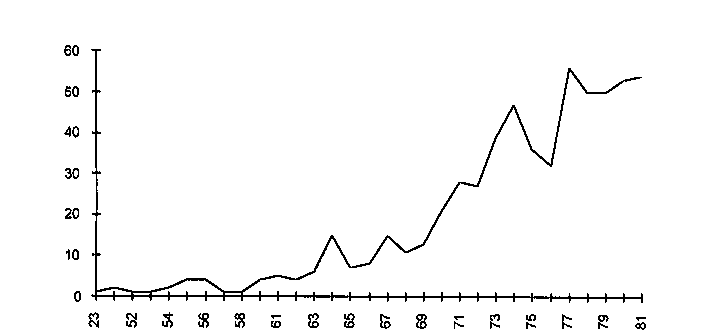
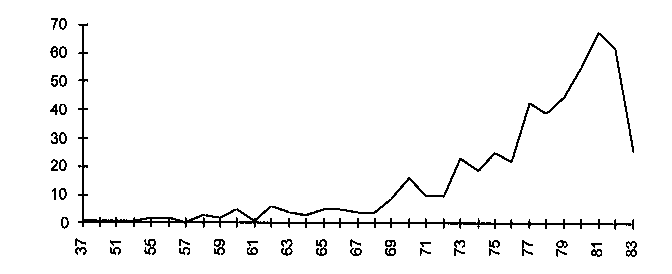
Year of Publication
(b) ICIS 1983: number of articles referenced by year (1937-1983)
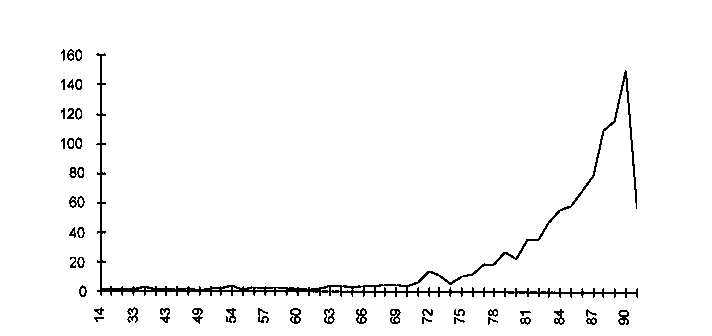
Year of Publication
(c) ICIS 1991: number of articles referenced by year (1914-1991)
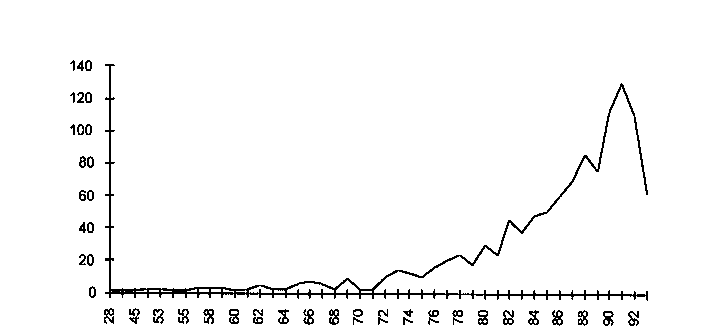
Year of Publication
(d) ICIS 1993: number of articles referenced by year (1928-1993)